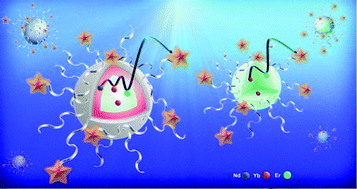Our official English website, www.x-mol.net, welcomes your feedback! (Note: you will need to create a separate account there.)
Er3+-to-dye energy transfer in DNA-coated core and core/shell/shell upconverting nanoparticles with 980 nm and 808 nm excitation of Yb3+ and Nd3.
Analyst ( IF 4.2 ) Pub Date : 2020/02/04 , DOI: 10.1039/c9an02532d Laura Francés-Soriano 1 , Nicola Peruffo , Marta Maria Natile , Niko Hildebrandt
Analyst ( IF 4.2 ) Pub Date : 2020/02/04 , DOI: 10.1039/c9an02532d Laura Francés-Soriano 1 , Nicola Peruffo , Marta Maria Natile , Niko Hildebrandt
Affiliation

|
The capability of upconverting nanoparticles (UCNPs) to convert near infrared (NIR) into visible light has become an important feature for biosensing, imaging, therapy, and their combination. While significant achievements have been accomplished during the last decade developing nanohybrids based on UCNPs as energy donors in Förster resonance energy transfer (FRET) systems, it is still challenging to understand and control FRET from UCNPs to dyes and to adapt the NIR excitation wavelength. Here, we describe the synthesis, characterization, and steady-state and time-resolved FRET analysis of UCNP-DNA nanohybrids, in which dye labelled single stranded (ss)DNA was attached to Yb-Er-co-doped core UCNPs (c-UCNPs) and c-UCNPs with a thin Nd-doped shell and a second thin undoped shell (css-UCNPs). Despite differences in sizes, compositions, donor-acceptor distances, brightness, and excitation wavelength (980 nm for Yb3+ and 808 nm for Nd3+), all UCNP-DNA nanohybrids showed very similar concentration dependent FRET-quenching of UCNP luminescence with efficiencies between 0 and ∼20%. We analyzed luminescence intensities, decay times, and rise times and could show the entanglement of excitation and emission kinetics by simply changing the excitation wavelength from 980 nm to 808 nm for the same css-UCNPs. Time-gated FRET-sensitized dye luminescence showed dye-ssDNA concentration dependence over four orders of magnitude (1 nM to 10 μM), which suggested a possible application to nucleic acid biosensing for both 808 and 980 nm excitation.
中文翻译:

Er3 +到染料的能量转移通过980 nm和808 nm的Yb3 +和Nd3激发在涂有DNA的核和核/壳/壳上转换纳米粒子中进行。
上转换纳米颗粒(UCNP)将近红外(NIR)转换为可见光的能力已成为生物传感,成像,治疗及其组合的重要特征。尽管在过去十年中已经取得了显著成就,但开发基于UCNP的纳米杂物作为Förster共振能量转移(FRET)系统中的能量供体,但要理解和控制从UCNPs到染料的FRET并适应NIR激发波长仍然是挑战。在这里,我们描述了UCNP-DNA纳米杂合体的合成,表征以及稳态和时间分辨FRET分析,其中染料标记的单链(ss)DNA连接到Yb-Er共掺杂的核心UCNPs(c- UCNPs和c-UCNPs,其中有一个薄的掺Nd壳和另一个薄的未掺杂壳(css-UCNP)。尽管尺寸,成分有所不同,供体-受体的距离,亮度和激发波长(Yb3 +为980 nm,Nd3 +为808 nm),所有UCNP-DNA纳米杂交体均表现出非常相似的浓度依赖性UCNP发光的FRET猝灭,效率在0至20%之间。我们分析了发光强度,衰减时间和上升时间,并且可以通过简单地将相同的css-UCNPs的激发波长从980 nm更改为808 nm来显示激发和发射动力学的纠缠。时间门控的FRET敏化的染料发光显示染料-ssDNA浓度在四个数量级(1 nM至10μM)上具有依赖性,这表明可能在808和980 nm激发中应用于核酸生物传感。所有的UCNP-DNA纳米杂交体均表现出非常相似的浓度依赖性UCNP发光的FRET猝灭,效率在0到20%之间。我们分析了发光强度,衰减时间和上升时间,并且可以通过简单地将相同的css-UCNPs的激发波长从980 nm更改为808 nm来显示激发和发射动力学的纠缠。时间门控的FRET敏化的染料发光显示染料-ssDNA浓度在四个数量级(1 nM至10μM)上具有依赖性,这表明可能在808和980 nm激发中应用于核酸生物传感。所有的UCNP-DNA纳米杂交体均表现出非常相似的浓度依赖性UCNP发光的FRET猝灭,效率在0到20%之间。我们分析了发光强度,衰减时间和上升时间,并且可以通过简单地将相同的css-UCNPs的激发波长从980 nm更改为808 nm来显示激发和发射动力学的纠缠。时间门控的FRET敏化的染料发光显示染料-ssDNA浓度在四个数量级(1 nM至10μM)上具有依赖性,这表明可能在808和980 nm激发中应用于核酸生物传感。对于相同的css-UCNPs,只需将激发波长从980 nm更改为808 nm,就可以显示出激发和发射动力学的纠缠。时间门控的FRET敏化的染料发光显示染料-ssDNA浓度在四个数量级(1 nM至10μM)上具有依赖性,这表明可能在808和980 nm激发中应用于核酸生物传感。对于相同的css-UCNPs,只需将激发波长从980 nm更改为808 nm,就可以显示出激发和发射动力学的纠缠。时间门控的FRET敏化的染料发光显示染料-ssDNA浓度在四个数量级(1 nM至10μM)上具有依赖性,这表明可能在808和980 nm激发中应用于核酸生物传感。
更新日期:2020-03-31
中文翻译:

Er3 +到染料的能量转移通过980 nm和808 nm的Yb3 +和Nd3激发在涂有DNA的核和核/壳/壳上转换纳米粒子中进行。
上转换纳米颗粒(UCNP)将近红外(NIR)转换为可见光的能力已成为生物传感,成像,治疗及其组合的重要特征。尽管在过去十年中已经取得了显著成就,但开发基于UCNP的纳米杂物作为Förster共振能量转移(FRET)系统中的能量供体,但要理解和控制从UCNPs到染料的FRET并适应NIR激发波长仍然是挑战。在这里,我们描述了UCNP-DNA纳米杂合体的合成,表征以及稳态和时间分辨FRET分析,其中染料标记的单链(ss)DNA连接到Yb-Er共掺杂的核心UCNPs(c- UCNPs和c-UCNPs,其中有一个薄的掺Nd壳和另一个薄的未掺杂壳(css-UCNP)。尽管尺寸,成分有所不同,供体-受体的距离,亮度和激发波长(Yb3 +为980 nm,Nd3 +为808 nm),所有UCNP-DNA纳米杂交体均表现出非常相似的浓度依赖性UCNP发光的FRET猝灭,效率在0至20%之间。我们分析了发光强度,衰减时间和上升时间,并且可以通过简单地将相同的css-UCNPs的激发波长从980 nm更改为808 nm来显示激发和发射动力学的纠缠。时间门控的FRET敏化的染料发光显示染料-ssDNA浓度在四个数量级(1 nM至10μM)上具有依赖性,这表明可能在808和980 nm激发中应用于核酸生物传感。所有的UCNP-DNA纳米杂交体均表现出非常相似的浓度依赖性UCNP发光的FRET猝灭,效率在0到20%之间。我们分析了发光强度,衰减时间和上升时间,并且可以通过简单地将相同的css-UCNPs的激发波长从980 nm更改为808 nm来显示激发和发射动力学的纠缠。时间门控的FRET敏化的染料发光显示染料-ssDNA浓度在四个数量级(1 nM至10μM)上具有依赖性,这表明可能在808和980 nm激发中应用于核酸生物传感。所有的UCNP-DNA纳米杂交体均表现出非常相似的浓度依赖性UCNP发光的FRET猝灭,效率在0到20%之间。我们分析了发光强度,衰减时间和上升时间,并且可以通过简单地将相同的css-UCNPs的激发波长从980 nm更改为808 nm来显示激发和发射动力学的纠缠。时间门控的FRET敏化的染料发光显示染料-ssDNA浓度在四个数量级(1 nM至10μM)上具有依赖性,这表明可能在808和980 nm激发中应用于核酸生物传感。对于相同的css-UCNPs,只需将激发波长从980 nm更改为808 nm,就可以显示出激发和发射动力学的纠缠。时间门控的FRET敏化的染料发光显示染料-ssDNA浓度在四个数量级(1 nM至10μM)上具有依赖性,这表明可能在808和980 nm激发中应用于核酸生物传感。对于相同的css-UCNPs,只需将激发波长从980 nm更改为808 nm,就可以显示出激发和发射动力学的纠缠。时间门控的FRET敏化的染料发光显示染料-ssDNA浓度在四个数量级(1 nM至10μM)上具有依赖性,这表明可能在808和980 nm激发中应用于核酸生物传感。


























 京公网安备 11010802027423号
京公网安备 11010802027423号